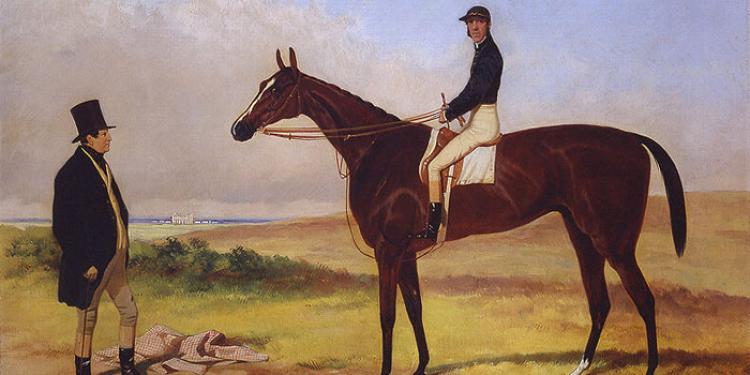The Most Famous Racehorses, Part 1: The First 5 (and A Little History)
Posted: March 30, 2016
Updated: March 30, 2016

Being a most famous racehorse comes with its challenges but these horses have obvious talent and the right ingredients to be a true winner. Here is the first chapter of insight for horses who truly were remarkable.
Spanning centuries, horse racing has been written about, practiced and glorified in legend in a multitude of civilizations across the world. Through time and modernization, the 18th, 19th, 20th and 21st centuries have had their share of some the most famous racehorses of all time. To bet on sports was forever changed when the art of this sport became more refined. This is part 1 in our series on famous racehorses. Read Part 2 and Part 3.
Eclipse (1764-1789):
The Most Famous Racehorse of the 18th Century
Firstly, before going into Eclipse’s grandeur, thoroughbred horses were brought into the West from the Middle East and were considered, and still are, the best breed for racing. At the time that Eclipse was dominating an era of somewhat primitive horseracing style and tactics, the concept of betting on horses became a sport and inspired better horse racing technicalities. Eclipse, having won literally every race in his 18-race career became an icon, a relic and to this day there are awards and races dedicated in his honor.
West Australian (1852-1854):
UK’s First National Horseracing Pride and Icon
This British Thoroughbred, a cross between Arabian steed and Thoroughbred mare, had a gorgeous yet slightly peculiar figure: longer than average legs and ideal body for horseracing. Having won nine out of ten of his races in the biggest events at that time. One being the Epsom Derby, starting in 6/4 along against 27 other racehorses. Horse betting in the UK at that time had become more popular and people still talk about this legendary race. West Australian came in first in the final furlong, winning by a neck to claim the whopping £5,425 first prize.
Through a continuous series of wins he was officially recorded as the first Triple Crown winner, though this was a few years before the term Triple Crown was established. Because of his success, he was retired in very comfortable surroundings and was sire to several quite successful horses. He later died in France with his bust marking the area and horse institutions and awards named after him.
Flying Fox (1896-1911):
Beauty and Charm of the Victorian Era
Known historically as a very difficult horse to handle with a slightly volatile temperament, Flying Fox was competitive for only two years and was retired as a successful sire. In these two years of racing, Flying Fox raced six races undefeated as well as becoming the 8th U.K. Triple Crown Champion. His time as sire became even more successful than his time racing and made more money doing this as well as producing future champion racehorses in their own right.
Man O’ War (1917-1947):
The Racehorse of Hope and Promise After WWI
Probably considered the greatest Thoroughbred racehorse of all time, still to this day beloved, and maybe the most famous racehorse of the US, Man O’ War tokened as ”the Mostest Horse” and a ”Living Legend.” Starting out as a two year old with one loss, he was raced again at three and won 20-21 races. For horseracing in the US and racehorse betting in the US, it is believed that his races literally raked in $249,465 in gambling winnings. Radio was relatively new and gambling news ran rampant through serious influx of gambling activity. The money then was so considerable, that numbers are expected to be higher than that on off book bets… probably breaking some US gambling laws at the time.
For many after the war, this horse would take their minds off of the stresses of recent past and started making horseracing American history. Man O’War set a new track record at Pimlico running 1:38-3/5 for a mile. This proved so fast that they had to slow him down to finish the last eighth at 1:51-3/5 for a possible future record breaker. Later he finished a 1 and 3/8 mile race by 20 lengths in a record 2:14.20 raising the belief that this horse could not be beat. After that, he won every race he was in, becoming feared and invincible. He went on to set several more horse racing world records (beating his own), and add continuous wins to his unbeatable position. To see him run, there is the first race to be filmed in its entirety: Keniworth Park Gold Cup 1920.
It should also be noted that this most famous racehorse had a great life in retirement and also made another record, by becoming a top sire and producing more than 64 colts, who were to become stakes winners and various champions. When he died, it was covered in US gambling news as mourners listened and he was also placed in his own silk lined coffin.
Phar Lap (1926-1932):
An Appropriate Name and Favorite During the Depression
This would be the horse that made heads turn towards Australia and pay attention to Australasian horse racing. Phar Lap would take over the world by first starting his wins across the map of Australian racing. Through his time, racing ballots for betting on horseracing, would also call him Wonder Horse, Red Terror and Big Red, though belovedly referred to Australia’s wonder horse. What is great about this particular famous racehorse, is his ugliness and hopelessness in the beginning of his life. Born in New Zealand, sold to Australia, he looked so unpromising that his trainer famously trained for free to placate the buyer.
With a rough start and many losses, with determination and slow wins, the public started to respect him, and word got around about his potential. It is told that in 1930 an attempt on his life was made, fortunately missing and the following day he raced, winning the Melbourne Stakes and three days later the Melbourne Cup as odds-on 8-11 favorite. After that it was an upcurve win of 37 to 51 wins the following year, then a following 14 wins in a row the next. He was now considered unbeatable and continued to the US to race as the gambling news was rife on this mystery horse.
Taken to the US, Phar Lap had a success in his distant cousin’s land winning the Agua Caliente Handicap breaking two new records in both largest prize money ever to be offered in North American racing and by winning a track-record time while carrying 129 pounds. That marked him as the horse to see, and his owner made sure of it. Unfortunately, due to large exposure and popularity Phar Lap died suddenly, which most speculate was due to being poisoned by an envious rival. The world was truly saddened by this ugly ducking horse turned swan. He was so beloved in Australia that Phar Lap’s skin was preserved exhibited as a taxidermy mount in the Melbourne Museum.












